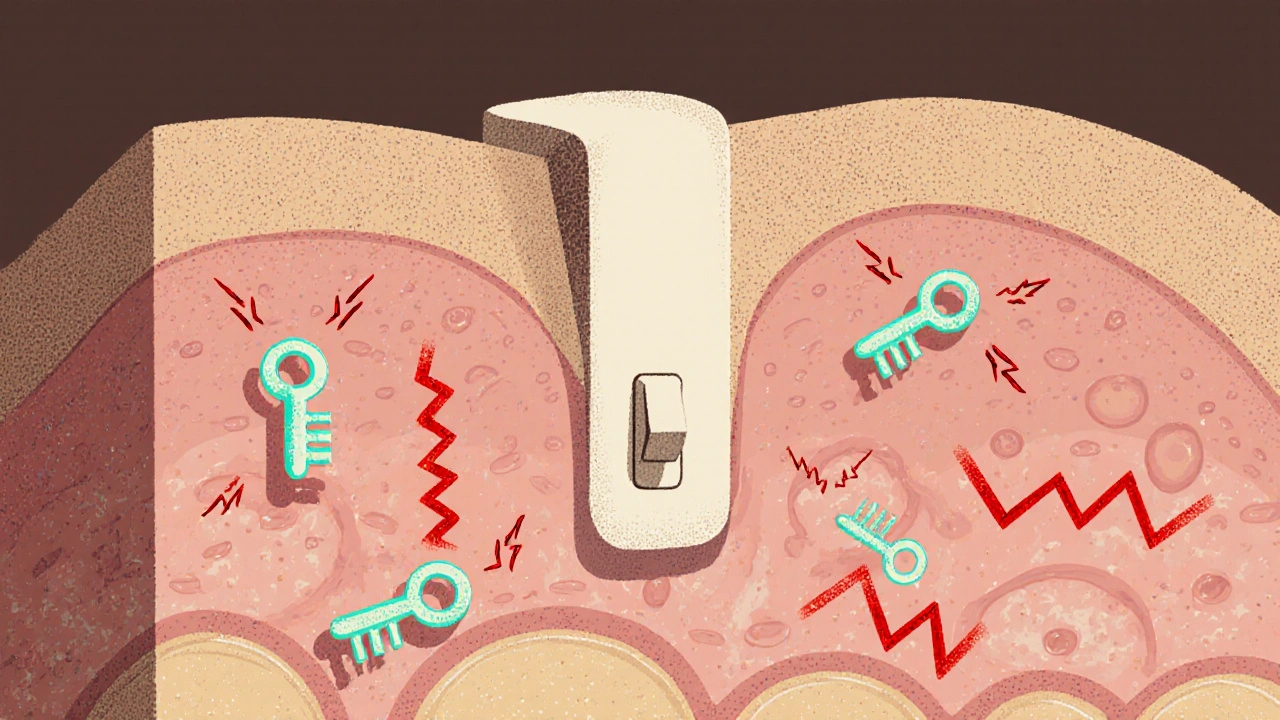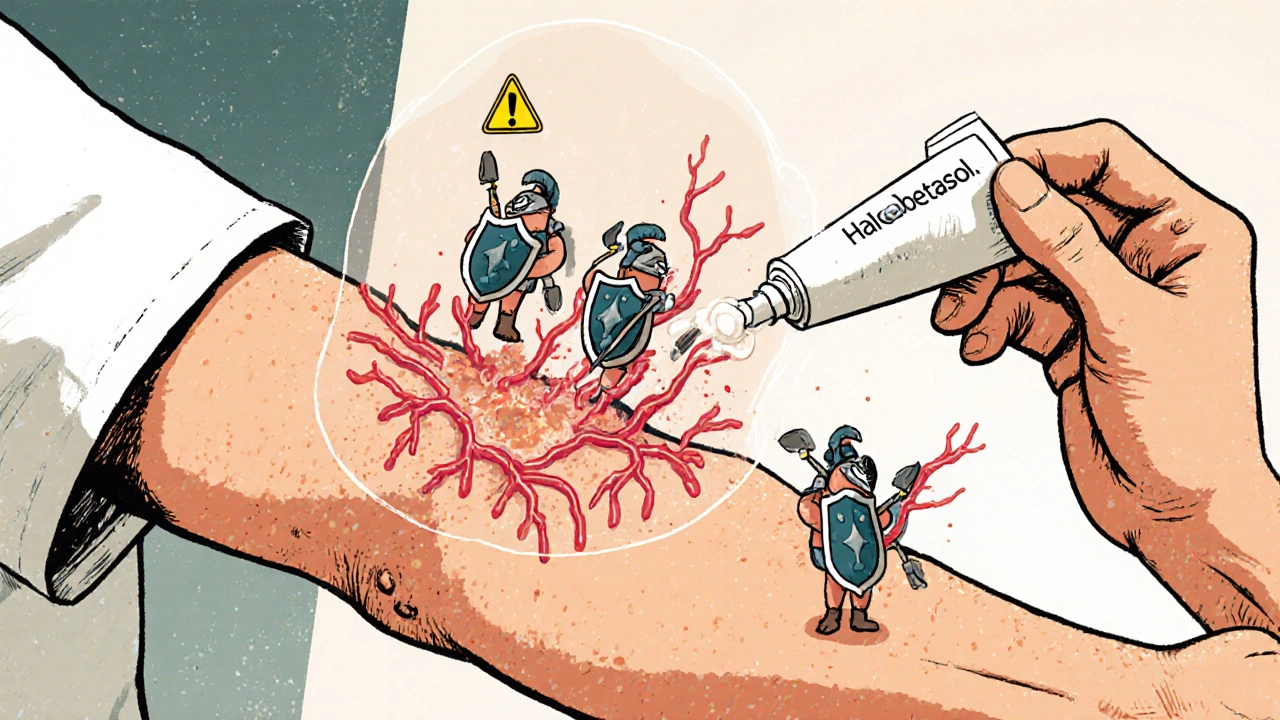The Science Behind Halobetasol: How This Powerful Steroid Works on Skin

Halobetasol doesn’t just calm red, itchy skin-it shuts down the body’s inflammatory response at the molecular level. If you’ve been prescribed this medication for psoriasis, eczema, or another stubborn skin condition, you might wonder: how does something so strong actually work? The answer isn’t just "it reduces swelling." It’s a precise, powerful biological takeover that stops your immune system from attacking your own skin.
What Halobetasol Actually Is
Halobetasol propionate is a synthetic corticosteroid, part of the glucocorticoid family. It’s classified as a Class I steroid-the strongest available for topical use. That means it’s not something you use lightly. Unlike over-the-counter hydrocortisone, halobetasol was designed for severe, resistant skin conditions. It’s not an antibiotic. It doesn’t kill bacteria. It doesn’t moisturize. It reprograms your skin’s immune signals.
Its chemical structure lets it slip easily through the outer layers of skin and bind tightly to glucocorticoid receptors inside skin cells. Once inside, it acts like a master switch. This switch controls hundreds of genes involved in inflammation, cell growth, and immune activity. When activated, it turns off the genes that make your skin red, swollen, and itchy.
How It Stops Inflammation
When your skin gets irritated-whether from eczema, psoriasis, or an allergic reaction-your body releases inflammatory chemicals like cytokines, prostaglandins, and histamine. These molecules attract immune cells to the area, causing swelling, heat, and pain. In chronic conditions, this process never turns off.
Halobetasol steps in and blocks this chain at multiple points. First, it suppresses the production of those inflammatory chemicals. It does this by binding to glucocorticoid receptors in the nucleus of skin cells. This binding changes how DNA is read, preventing the instructions for making those chemicals from being copied.
Second, it reduces the number of immune cells that show up. T-cells, mast cells, and neutrophils-all key players in skin inflammation-are kept from migrating into the affected area. Without them, the cycle of irritation breaks.
Third, it tightens blood vessels. That’s why your skin looks less red after a few days of use. The narrowed capillaries mean less blood flow to the inflamed zone, which reduces both swelling and the delivery of more immune cells.
Why It Works So Fast-And Why That’s a Double-Edged Sword
Many people notice improvement in just 24 to 48 hours. That speed is why doctors reach for halobetasol when other treatments fail. But that same speed is why misuse is dangerous.
Unlike weaker steroids that take days to build up effects, halobetasol binds so tightly to receptors that it starts working almost immediately. This makes it effective-but also more likely to cause side effects if used too long or on sensitive areas.
Long-term use can thin the skin. You might notice stretch marks, easy bruising, or visible blood vessels. In rare cases, it can suppress the adrenal glands, which normally produce your body’s natural steroids. That’s why it’s never meant for daily, indefinite use. Most dermatologists prescribe it for no more than two weeks at a time, then switch to a gentler option.

Where It Works Best-and Where It Doesn’t
Halobetasol is most effective on thick, tough skin areas: elbows, knees, scalp, palms, and soles of the feet. These areas absorb the medication well and are often where psoriasis plaques or severe eczema build up.
But it’s a bad fit for thin skin. That includes the face, armpits, groin, and eyelids. Using it there increases the risk of skin atrophy-where the skin becomes paper-thin and fragile. It can also cause acne-like breakouts or perioral dermatitis, especially around the mouth.
Children under 12 shouldn’t use halobetasol unless under strict supervision. Their skin is more permeable, and their bodies are more sensitive to steroid effects. Even in adults, applying it under occlusive dressings (like plastic wrap) can lead to dangerous systemic absorption.
What Happens When You Stop Using It?
Some patients report rebound flares after stopping halobetasol. The skin, having been suppressed, reacts with even more redness and itching than before. This isn’t addiction-it’s a rebound effect. The immune system, suddenly without the steroid’s control, overcompensates.
To avoid this, doctors often recommend tapering. Instead of stopping cold, you might switch to a weaker steroid for a week or use a non-steroidal alternative like pimecrolimus or tacrolimus. Moisturizing daily with ceramide-rich creams also helps rebuild the skin barrier after steroid withdrawal.
How It Compares to Other Steroids
Here’s how halobetasol stacks up against other common topical steroids:
| Steroid | Class | Typical Use | Max Duration | Risk of Skin Thinning |
|---|---|---|---|---|
| Hydrocortisone 1% | Class VII | Mild eczema, diaper rash | Up to 4 weeks | Low |
| Triamcinolone 0.1% | Class IV | Moderate psoriasis, eczema | 2-4 weeks | Moderate |
| Fluocinonide 0.05% | Class II | Severe plaque psoriasis | 2 weeks | High |
| Halobetasol 0.05% | Class I | Resistant psoriasis, chronic eczema | 1-2 weeks | Very High |
Halobetasol is the strongest in this group. It’s not a first-line treatment. It’s reserved for cases where other options have failed. That’s why you won’t find it on drugstore shelves-it requires a prescription.

Real-World Use: What Patients Actually Experience
One 2023 study tracking 1,200 patients with moderate-to-severe plaque psoriasis found that 83% saw significant improvement in scaling and redness after 14 days of daily halobetasol use. But 17% developed mild skin thinning, and 8% reported rebound flare-ups after stopping.
Patients who combined halobetasol with daily emollients reported fewer side effects and longer remission periods. The key wasn’t just the steroid-it was what they did after.
Another common scenario: a patient uses halobetasol on their scalp for psoriasis. After two weeks, the plaques vanish. But if they stop using moisturizer and start using harsh shampoos, the condition returns within weeks. The steroid cleared the inflammation, but didn’t fix the underlying barrier dysfunction.
When to Talk to Your Doctor
You should call your doctor if:
- Your skin becomes shiny, stretched, or transparent
- You develop purple or red streaks (striae)
- Your acne worsens or you get small bumps around your mouth
- You feel unusually tired, dizzy, or nauseated (possible adrenal suppression)
- The condition returns worse than before after stopping
These aren’t rare. They’re predictable outcomes of improper use. Halobetasol is powerful-but it’s not magic. It works best when used like a scalpel: precisely, briefly, and with a plan for what comes next.
What Comes After Halobetasol?
After a short course, the goal isn’t to keep using it-it’s to maintain results without it. Many dermatologists transition patients to:
- Non-steroidal topicals like tacrolimus (Protopic) or pimecrolimus (Elidel)
- Phototherapy (UVB light treatments)
- Systemic medications like methotrexate or biologics for severe cases
- Consistent use of fragrance-free moisturizers with ceramides, cholesterol, and fatty acids
Some patients benefit from a "steroid holiday"-a few weeks off steroids, followed by a return to a gentler regimen. This helps reset the skin’s natural balance.
The science behind halobetasol is clear: it’s one of the most potent tools we have to silence severe skin inflammation. But its power demands respect. Used right, it can change a patient’s life. Used wrong, it can leave lasting damage. That’s why it’s not just a cream-it’s a medical decision.
Is halobetasol the same as clobetasol?
Halobetasol and clobetasol are both Class I topical steroids and very similar in strength. Halobetasol is slightly more potent in lab tests, but in practice, dermatologists treat them as interchangeable for most conditions. The choice often comes down to formulation-cream, ointment, or foam-and patient preference.
Can I use halobetasol on my face?
No, unless specifically directed by a dermatologist for a very short time. The skin on your face is thin and sensitive. Halobetasol can cause permanent damage like skin atrophy, visible blood vessels, or steroid-induced acne. Even a few days of use can cause problems here.
How long does halobetasol stay in your system?
Topical halobetasol doesn’t circulate widely in the bloodstream when used correctly. Most of it stays in the skin. But if you use too much, cover it with bandages, or apply it to large areas, some can be absorbed. It has a half-life of about 2-3 hours in the blood, but its effects on skin cells last much longer-up to 72 hours after application.
Can halobetasol cause weight gain or mood changes?
Unlikely with normal use. Systemic side effects like weight gain, mood swings, or high blood pressure happen only with long-term, high-dose use-especially if applied to large areas or under occlusion. For most people using it as directed on small patches, these effects are extremely rare.
Is halobetasol safe for children?
It’s generally not recommended for children under 12. Their skin absorbs more medication, and their adrenal glands are more vulnerable to suppression. In rare, severe cases, a pediatric dermatologist may prescribe it for a very short time with strict monitoring.